Nuri Şahin’s influence at Borussia Dortmund extends beyond his years as a player, shaping a tactical vision that reflects both creativity and discipline. His understanding of the game, honed over years under top coaches, is now evident in his approach to managing and crafting Dortmund’s style of play. Dortmund’s structure under Şahin is built around a balance between attacking flexibility and quick transitions, allowing them to adapt to various opponents while maintaining their identity. This tactical analysis dives into the key elements of Şahin’s strategy, shedding light on how he has shaped Dortmund’s style of play and its impact on their performances.
Build-up
Low Build-up
In the low build-up, Şahin sets his team up in a 1-4-2-1-3 formation.
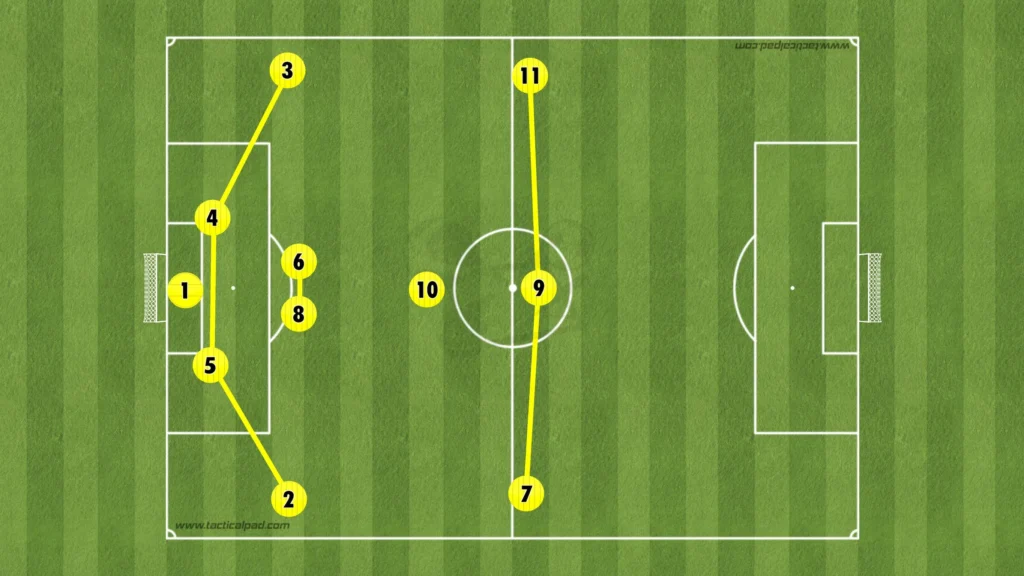
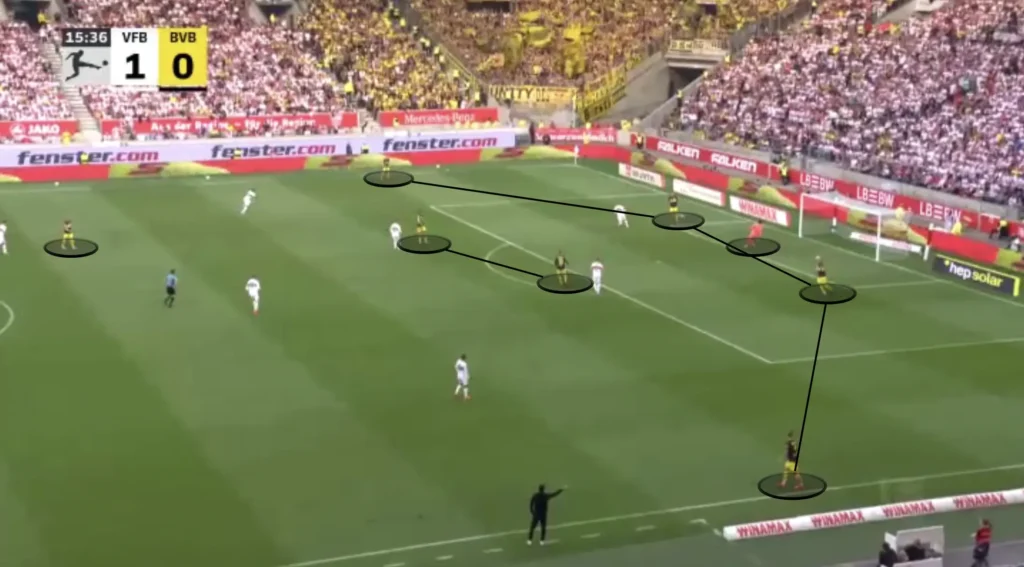
The wingers usually start wide and come in when the play starts. This often gives Dortmund a numerical superiority in the midfield, which will help them beat the opposition’s press. The wingers also have better conditions to win the second balls when they are in the middle. When the goalkeeper plays a long ball toward the striker, they will work together with the number-ten to win the second ball, which allows Dortmund to establish possession higher up the pitch.
High Build-up
In the high build-up, Şahin wants a winger to move in as an attacking midfielder and a fullback to push up as a winger.
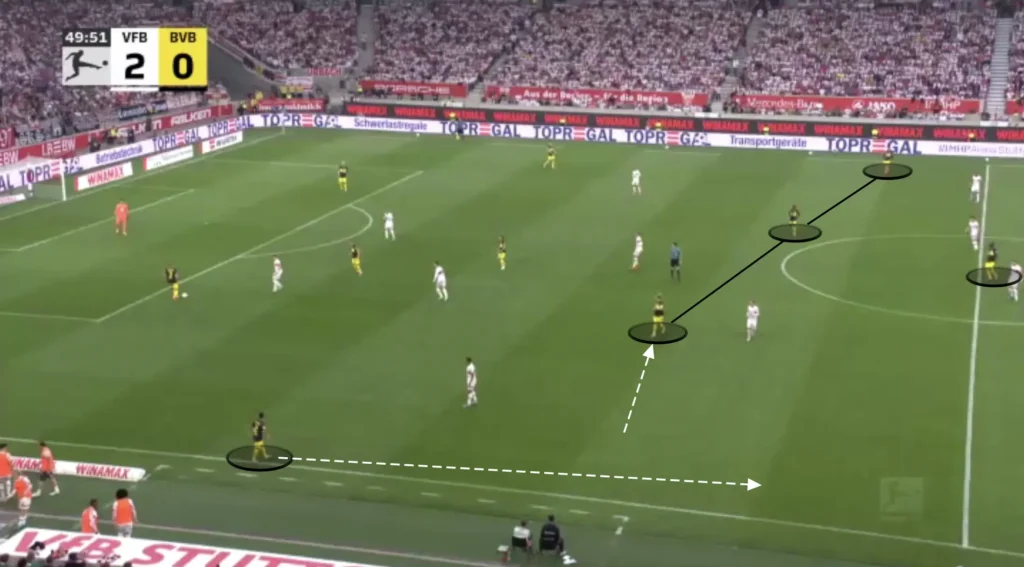
This puts Dortmund in a 1-3-2-5 formation.
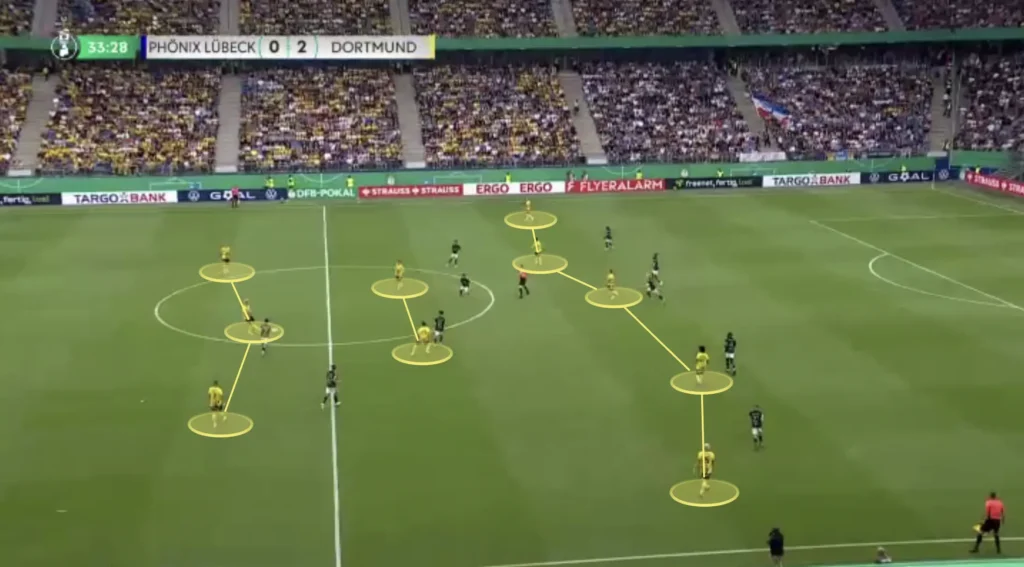
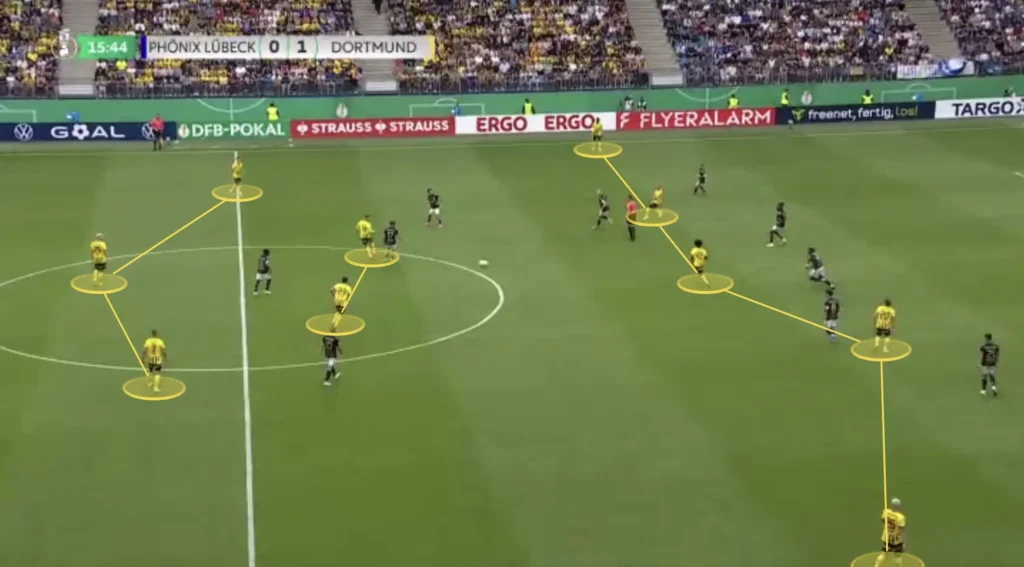
Building up in a 1-3-2-5 formation focuses on creating numerical superiority in the midfield while maintaining width through the winger. The three center-backs provide a solid defensive base, with the two wide center-backs stretching the opposition’s press, creating space for the wingers to push up and occupy the flanks. In midfield, the double pivot provides passing options and ensures control in the center, while the attacking midfielders stay high and centrally, ready to exploit any gaps in the opposition’s defense.
Şahin usually wants the two holding midfielders to be in different lines during the build-up. This is crucial for creating passing lanes and disrupting the opposition’s defensive structure.
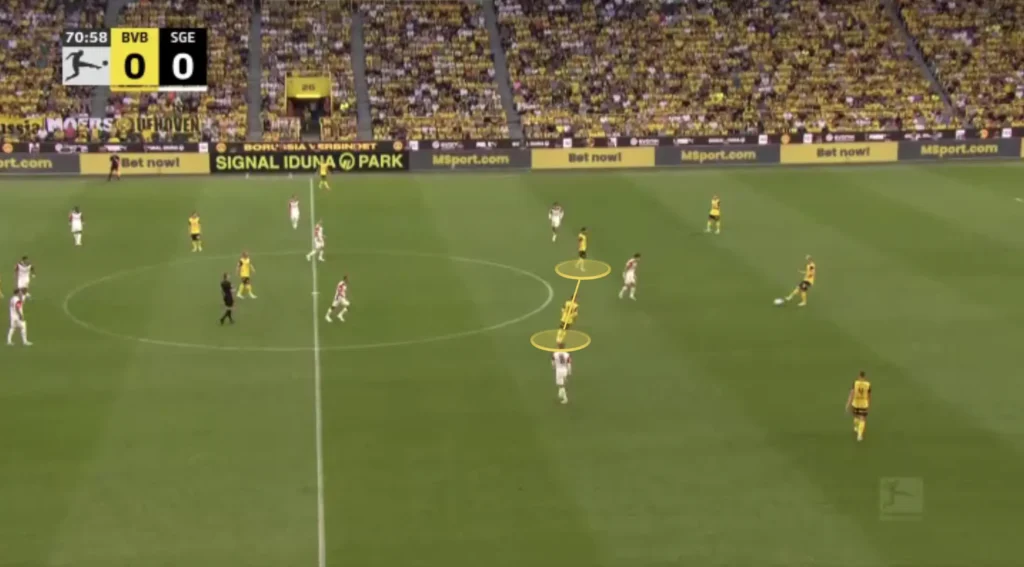
When the holding midfielders are staggered—one slightly ahead of the other—it forces the opposition’s attackers to make difficult decisions on who to block off, opening up space for the team to advance the ball. This layered positioning also enhances ball circulation by providing multiple angles for passing, reducing the risk of predictable or intercepted passes. The holding midfielders can play between themselves, allowing them to find third-man combinations to beat the opposition’s first line of pressure.
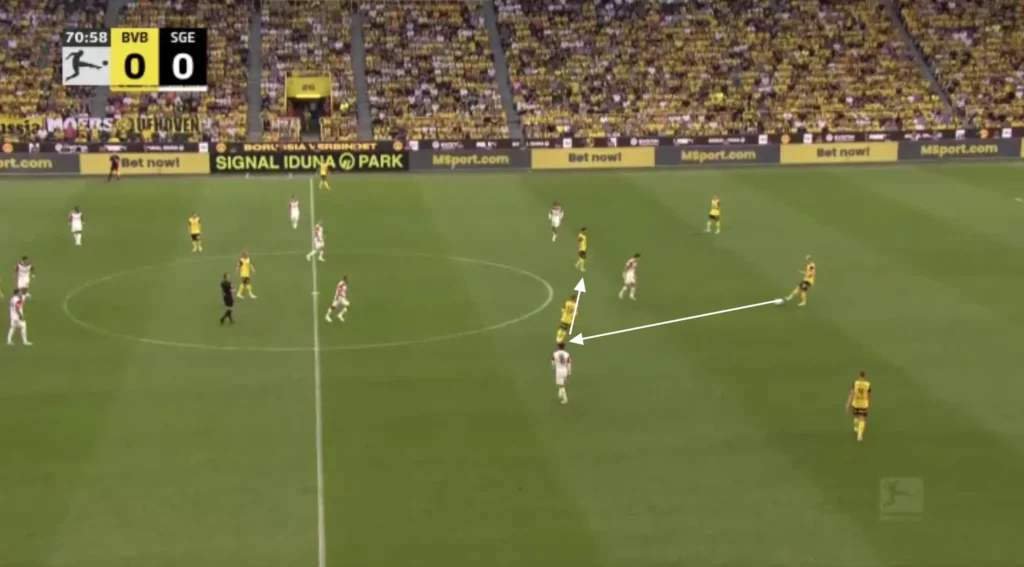
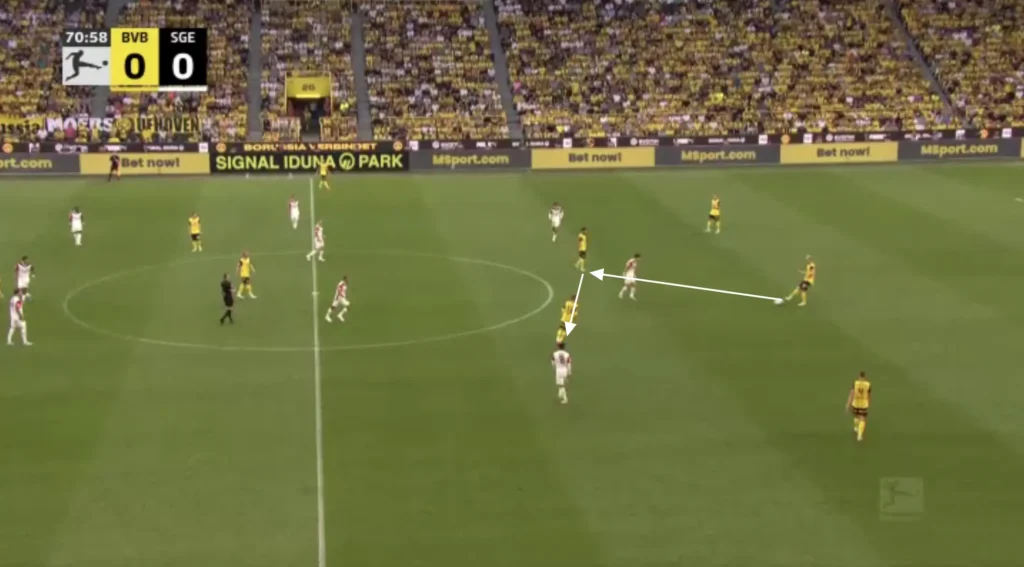
Şahin also focuses on keeping the wingers high and wide. This pulls apart the opposition’s defense and opens up more space for Dortmund’s midfielders.
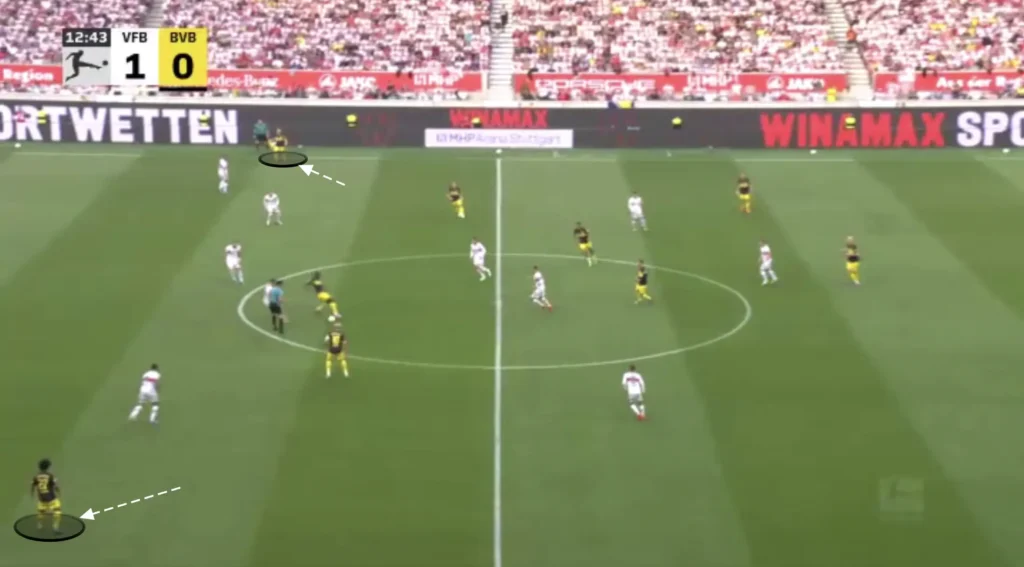
Fluidity
Dortmund’s fluidity in the build-up under Nuri Şahin has been a key aspect of their tactical evolution. The team often adopts a dynamic approach, shifting between formations to create numerical advantages and exploit spaces. Şahin’s focus is always to get the players into their best positions, where they can make the most out of their individual skills. He emphasizes versatility, with players interchanging positions seamlessly to maintain possession and disrupt the opposition’s defensive structure. One of the holding midfielders will often move up into a number-ten position, creating a 1-3-1-5-1 formation. This rotation gives Dortmund more players higher up the pitch and can help break down teams who defend deep in a low-block.
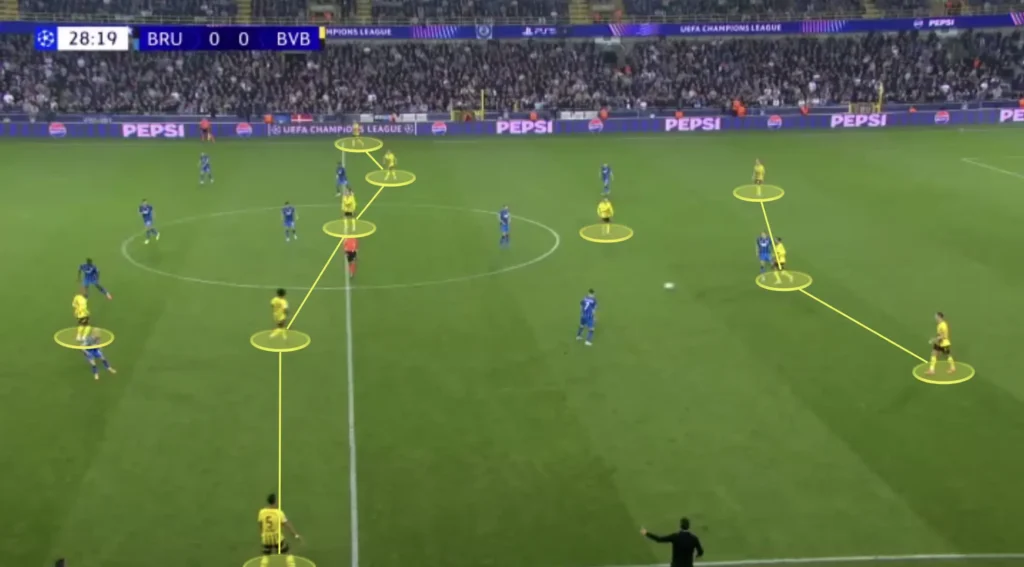
However, a holding midfielder can also drop into the backline to create numerical superiorities in the build-up phase. By having a holding midfielder drop between the center-backs, Dortmund can create a 1-4-1-5 formation, providing more passing options and greater control when progressing the ball from deep. This adjustment not only helps in bypassing an opponent’s press but also allows the wide center-backs to push out more, stretching the opposition’s forward line.

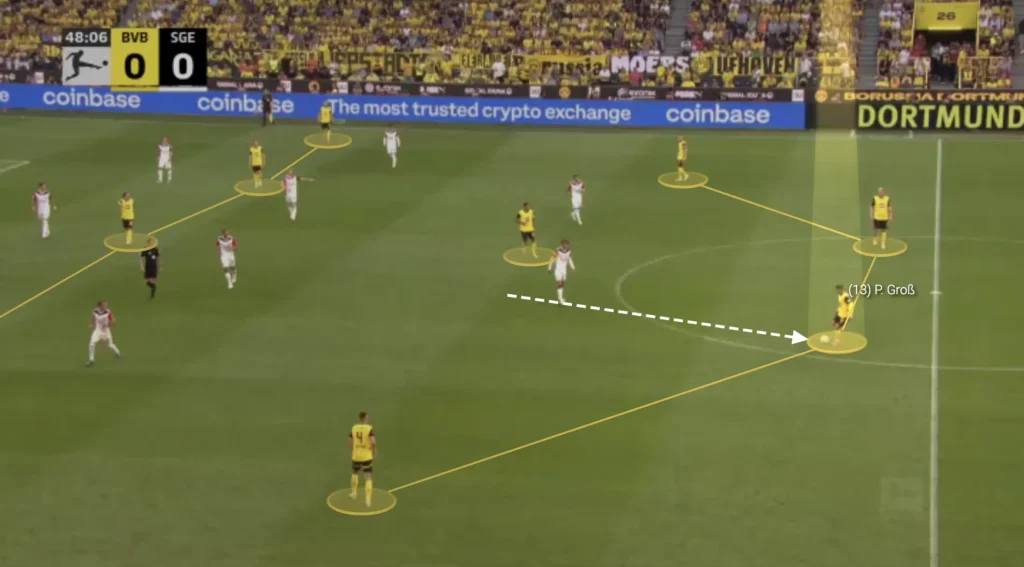
Numerical Superiority in the Midfield
Regardless of the formation, Dortmund will have many players in the center. Şahin usually has a winger on each side and positions the remaining eight players in the middle.
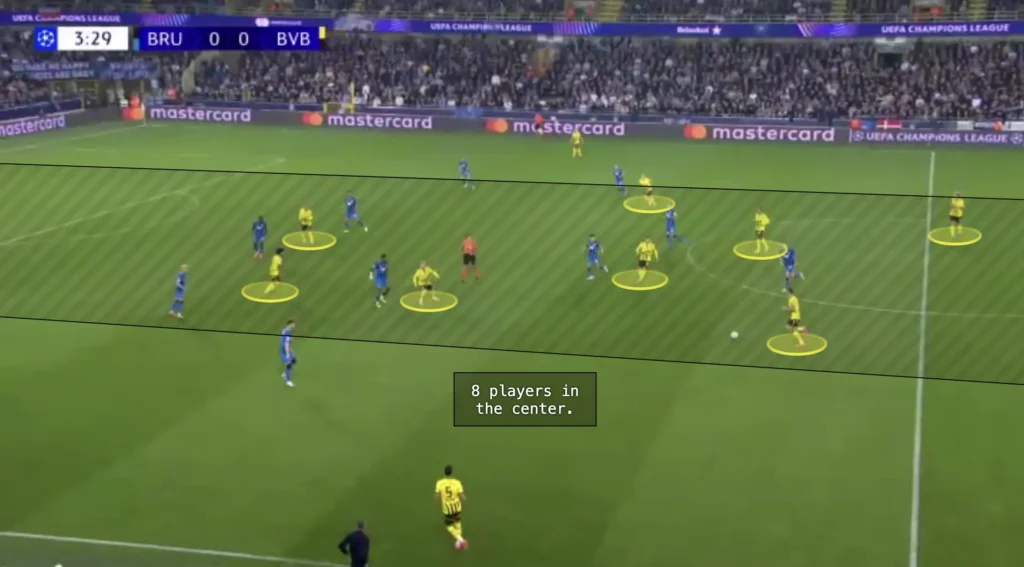
Having only the two wingers out wide and the rest in the middle creates more options in the center and less space between the players. Şahin likes this because he prioritizes playing through the middle. He needs one player out wide to pull the opposition apart while the rest create numerical advantages in the midfield areas. When a team outnumbers the opposition in the midfield, it can more easily retain the ball, exploit spaces, and progress the ball through the center. Dortmund will often progress the ball through quick central passes between the midfielders, beating the opposition’s press and exploiting gaps in the defense. At the same time, having many players centrally builds good conditions in defensive transitions since it allows more players to counterpress when they lose the ball.
Another purpose for keeping many players in the middle is to shorten the distance between them. This shortens the length of the passes, which naturally shortens the time between passes. This means the opposition players will have less time to push up and press, giving the Dortmund players more time and control.
High Backline (Off)
A massive aspect of Şahin’s high build-up is to have the defenders high up. This helps in the counterpress because they get closer to the center. Having more players close to the center who can win the ball back makes it difficult for the opposition to do anything when they win possession. Furthermore, the high backline shortens the distance between players, shortening the time and length of the passes and preventing the opposition from pushing up their defense.
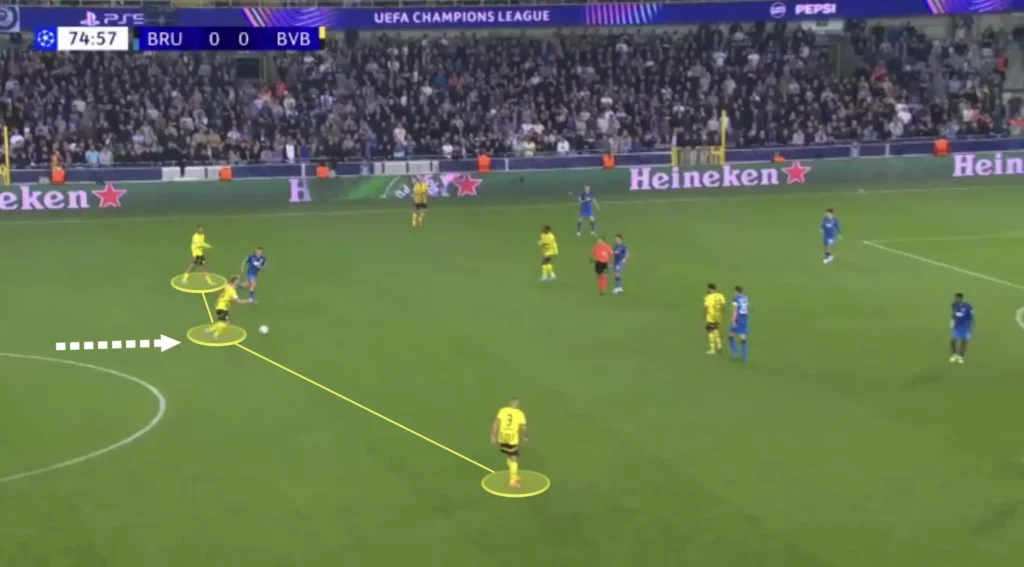
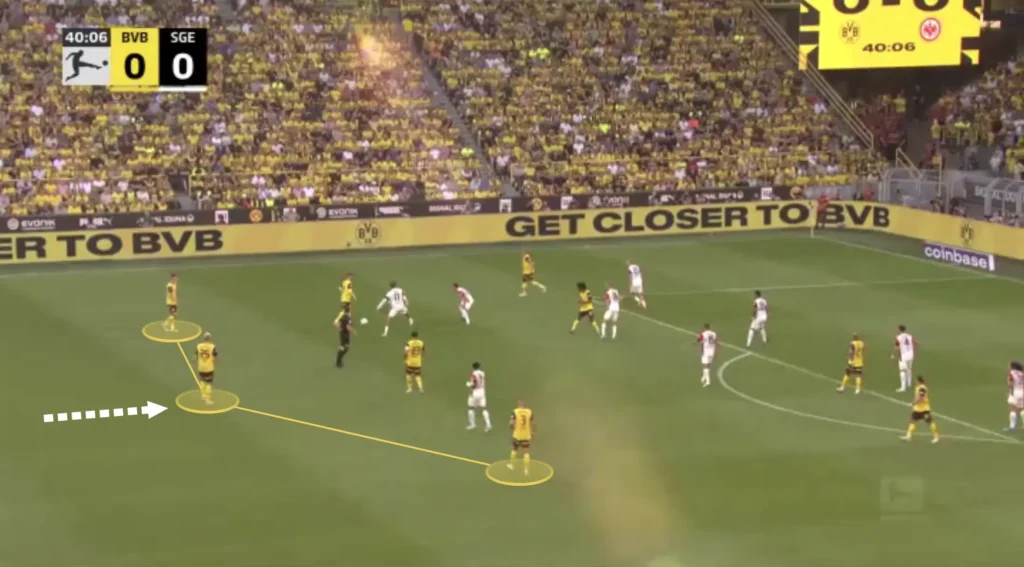
Finding the Pockets
Şahin’s players always try to find the attacking midfielders in the pockets. These “pockets” refer to the spaces between the opposition’s defensive and midfield lines, where the attacking midfielders can receive the ball in more advanced positions.
By positioning themselves intelligently in these pockets, the attacking midfielders can turn quickly and face the opposition’s goal, creating opportunities for through balls, driving runs, or direct shots. This positioning forces the opposition to make difficult decisions. If an opposition defender steps up and closes down the attacking midfielder, he potentially leaves space behind. If he stays back, he allows the midfielder time on the ball. The Dortmund defenders and holding midfielders will look for straight passes, breaking the opposition lines and finding the attacking midfielders who can turn and drive at the defense.
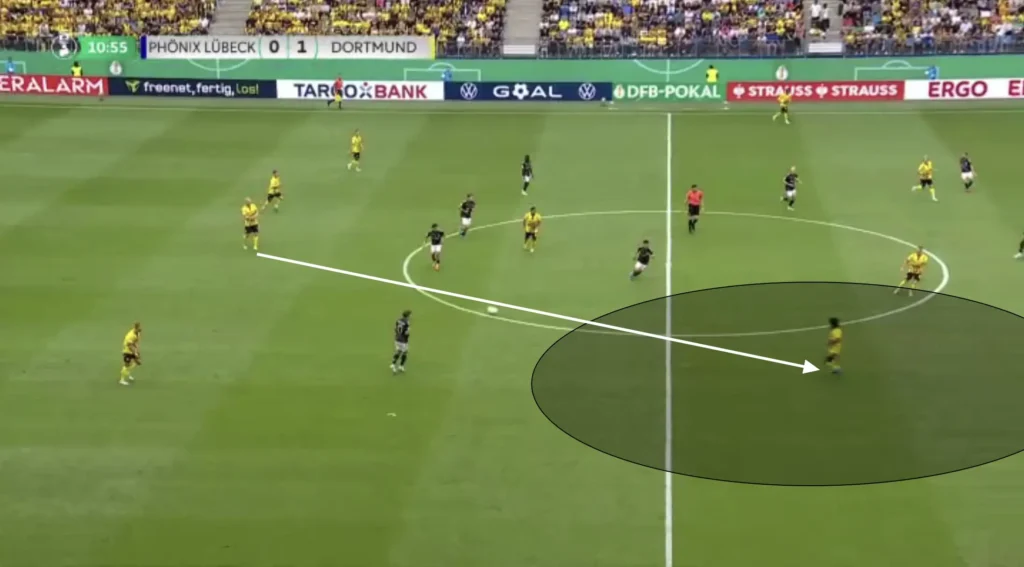
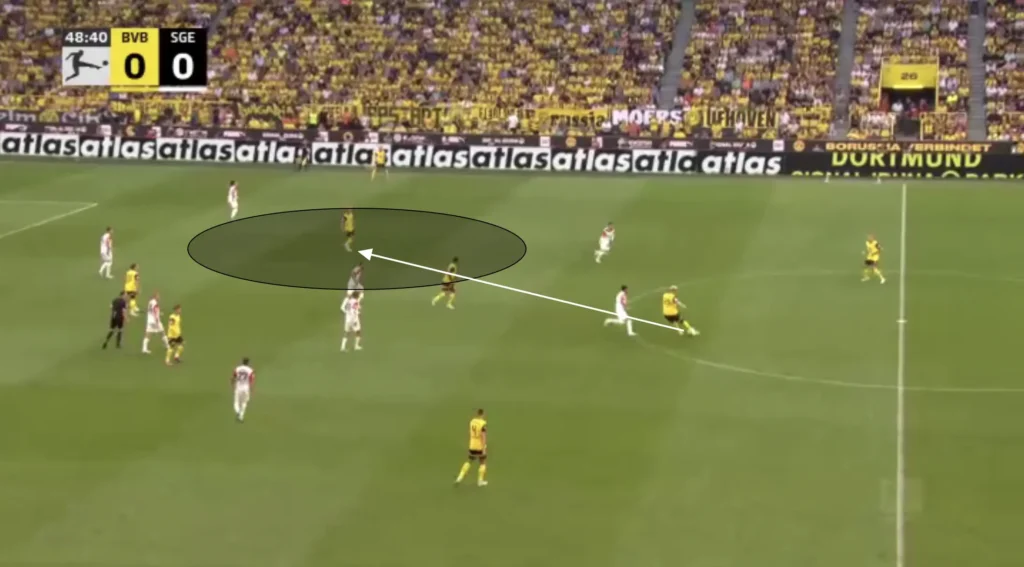
Finding these pockets is crucial for maintaining fluidity in attack and ensuring that the team can progress the ball effectively through the middle of the pitch.
Dropping Outside
When the opposition defends very compactly and does not allow the attacking midfielders to be found in the pockets, Dortmund’s attacking midfielders can drop outside to receive the ball there instead. They will wait for the opposition’s wide midfielders to come into the middle and drop out into the space outside of him. The opposition center-backs and central midfielders rarely follow these runs, not wanting to open the space in the center. Additionally, the winger, who is positioned high and wide, will be pinning the opposition fullback, not allowing him to jump on the dropping attacking midfielder. This means that the attacking midfielder can receive the ball, turn, and progress the ball unopposed.
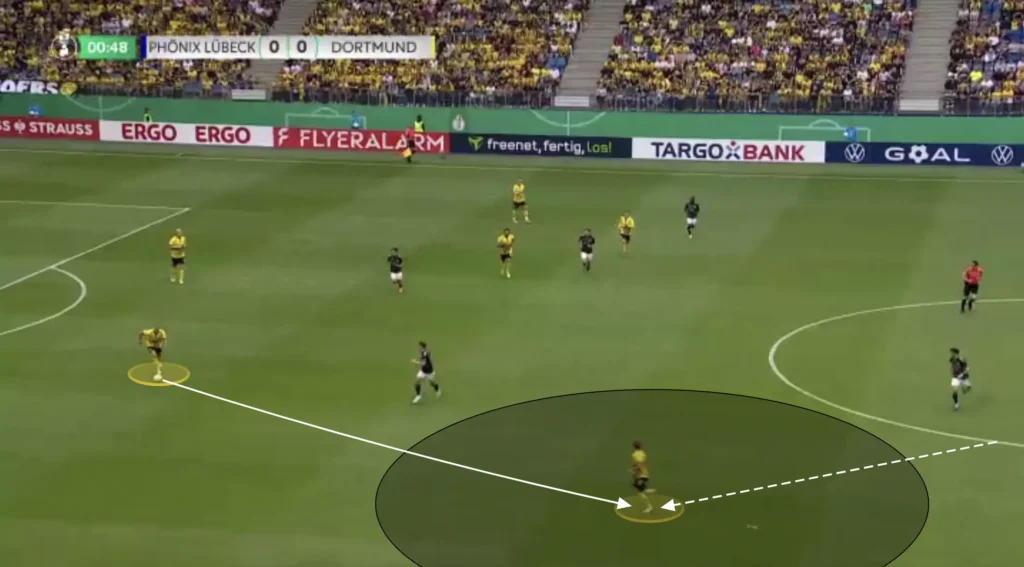
Linking with the Striker
Nuri Şahin likes to create central overloads when attacking the opposition. Therefore, the Dortmund striker often drops during the build-up. When the striker drops, Dortmund unlock more ways of beating the opponent’s defense. They can pass the ball to the striker, who can find an attacking midfielder in the pocket or play a one-touch pass out to the winger.
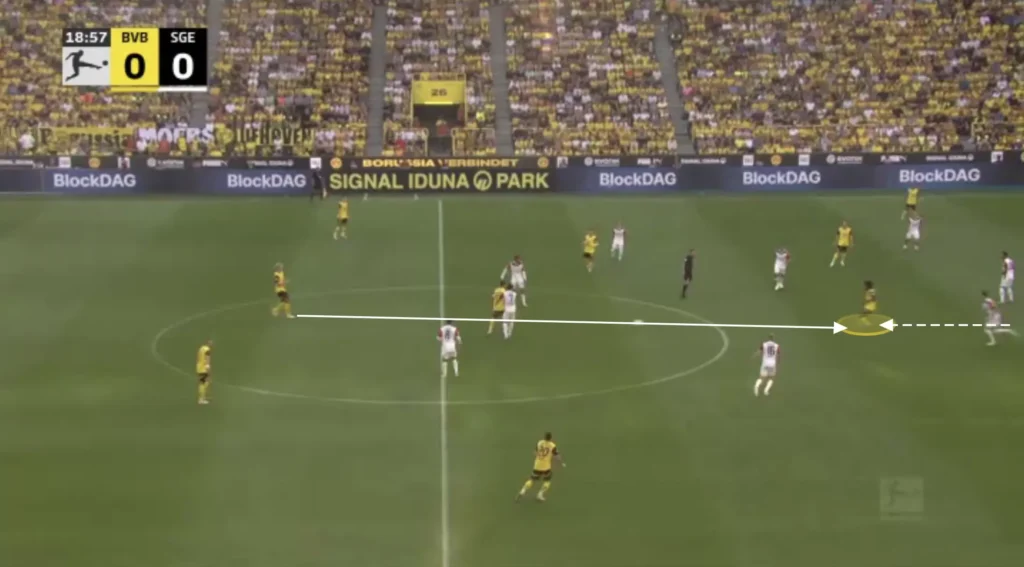
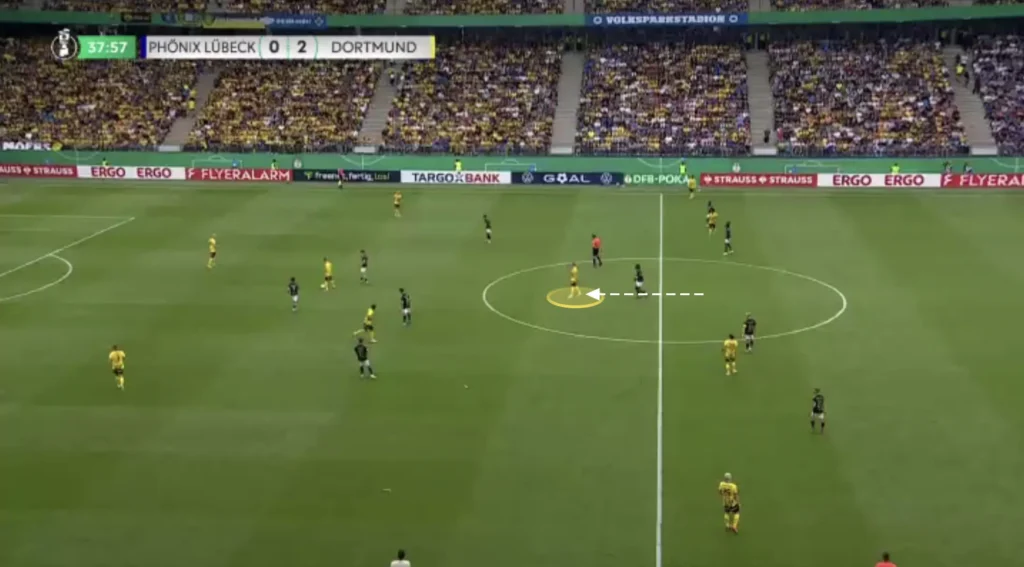
The striker dropping also creates a question for the opposition center-backs. If they step up on the dropping striker, the space behind them opens up, allowing Dortmund to play a through-ball to the attacking midfielder, making a run in behind. However, if they stay in the backline to cover the run, the ball can be played to the striker, who can turn and attack the defense.
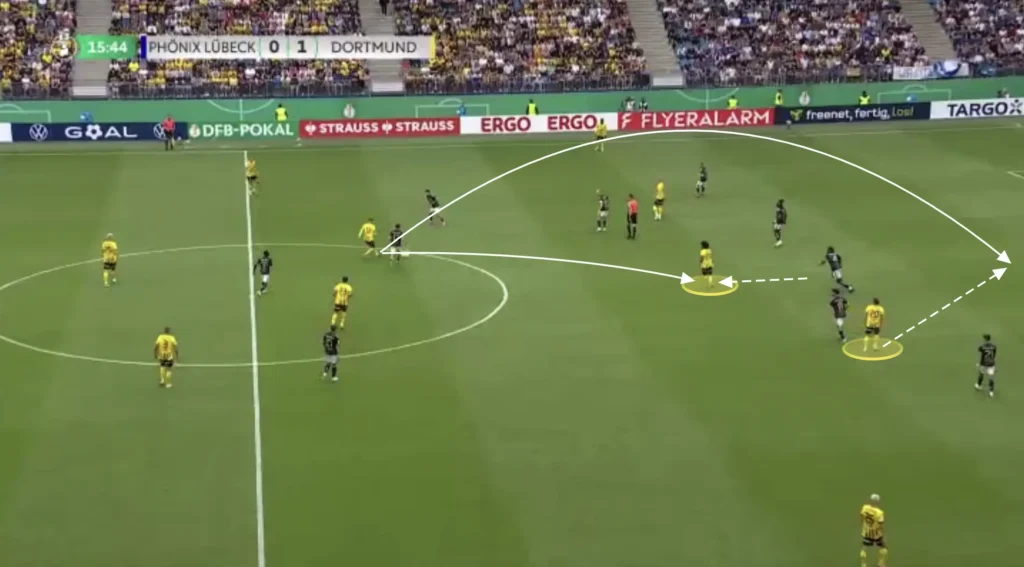
Creating 1v1 Situations
At Borussia Dortmund, creating 1v1 situations for the wingers against opposition fullbacks is a key part of their attacking strategy. By using quick ball circulation and positional play, Dortmund often stretch the field wide to isolate their wingers in direct confrontations with opposing fullbacks. This is achieved by drawing defenders inside with their attacking midfielders and forward, creating space for the wingers to exploit. When the ball is quickly switched to the wide areas, the wingers are positioned to use their pace and dribbling skills to beat the fullbacks and either get the ball into the box through a cross or cut inside to shoot.
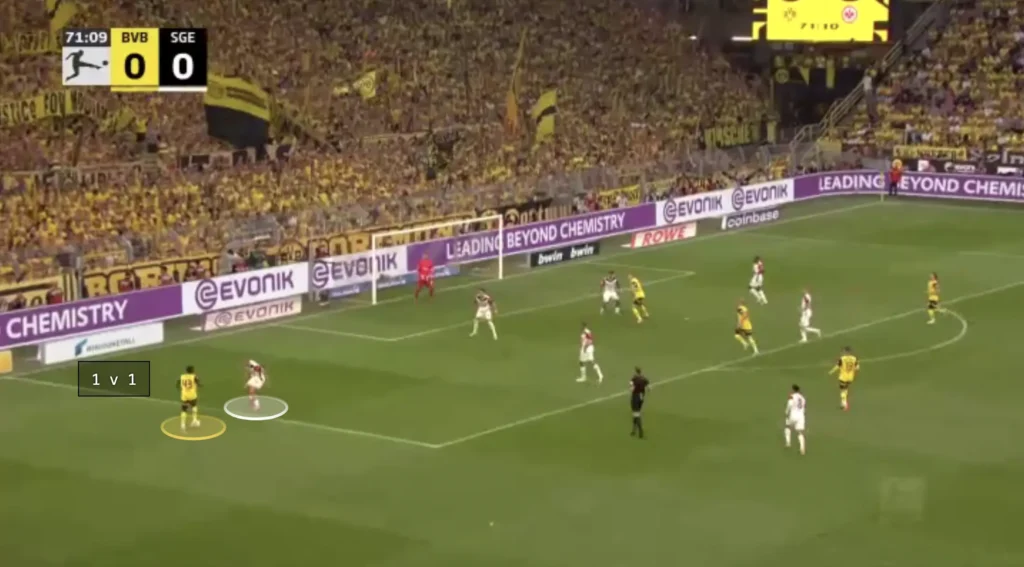
Numerical Advantages Against the Opposition’s Defense
A massive aspect of Dortmund’s high build-up is their ability to create numerical advantages against the opposition’s defensive line. Playing with a front five means the forward line naturally becomes numerically superior against a back four, which they are great at taking advantage of.
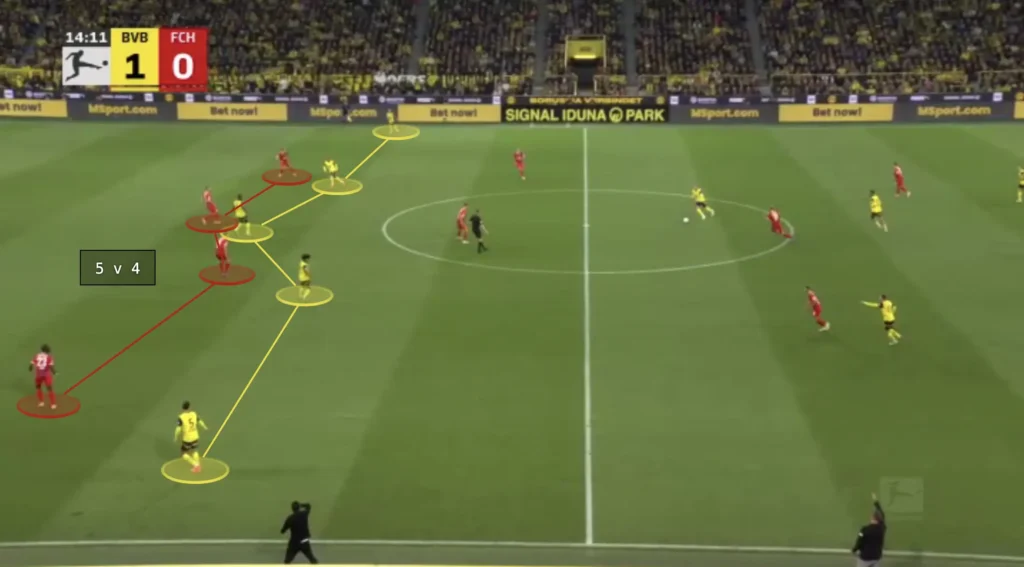
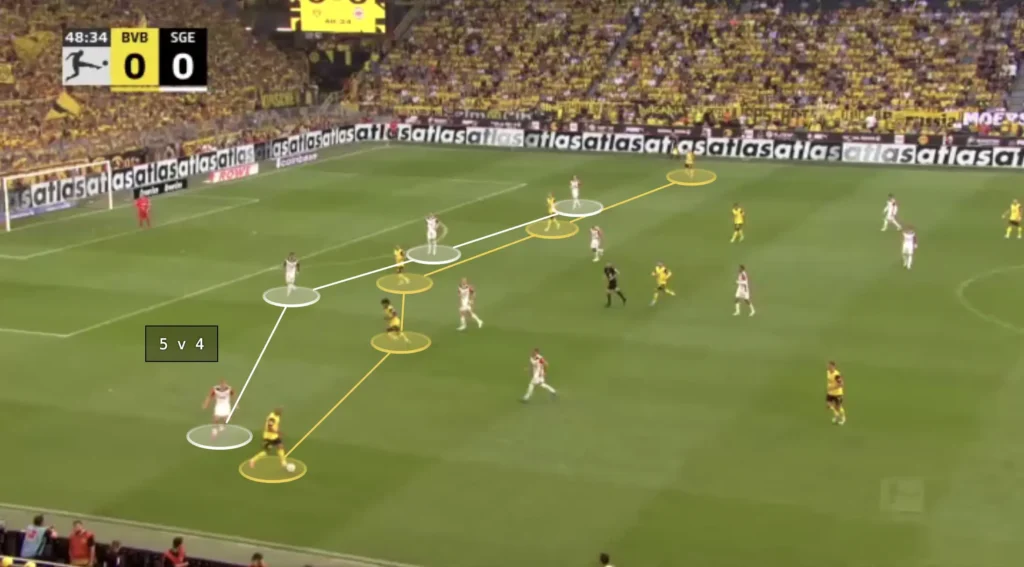
Şahin’s players mainly exploit this by creating 2v1 situations against the opposition fullback. When the defending team is positioned on one side, the weak-side fullback becomes vulnerable to the switch of play due to the 1v2 against Dortmund’s winger and attacking midfielder. The attacking midfielder will make a run in behind, the fullback will follow that run, and the space for the winger out wide will be opened. Şahin’s team often capitalizes on this by getting the ball to the winger and creating many opportunities from 2v1 situations on the wing and in the half-spaces.
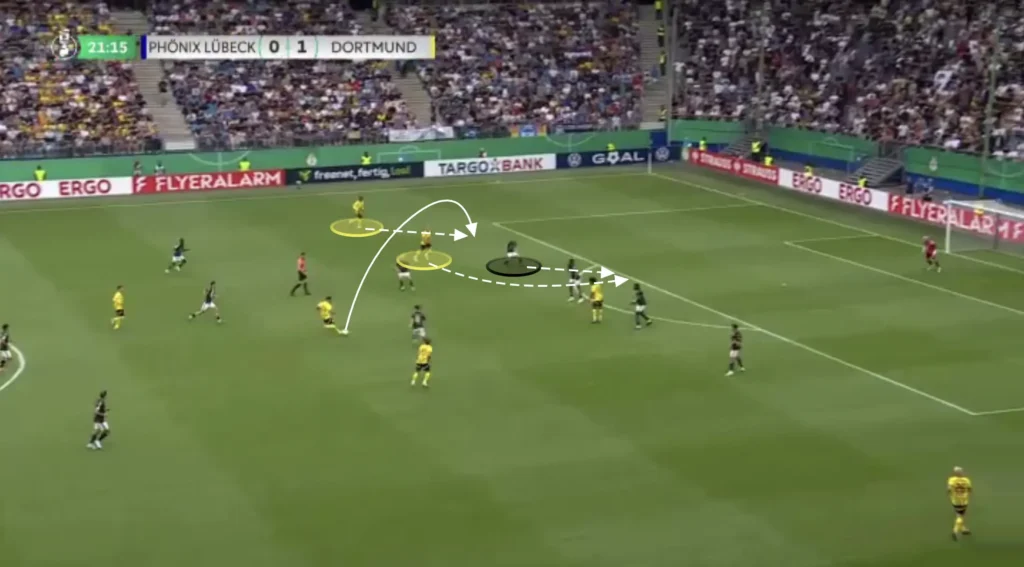
If the opposition fullback does not follow the attacking midfielder’s run, a through-ball could be played straight to the attacking midfielder, who could take the ball forward and create a 1v1 against the goalkeeper.
Attacking the Half-Space
Şahin’s players usually look to create chances by attacking the space between the opposition center-back and fullback. They primarily do this from the wide areas with underlaps from the attacking midfielders. When the winger receives the ball out wide he will attract the opposition fullback. This opens the space between the fullback and the center-back, which allows Dortmund’s attacking midfielder to make the underlapping run into this space. The ball can be played to the underlapping player, who can cross the ball into the box or attack his defender in a 1v1 situation.
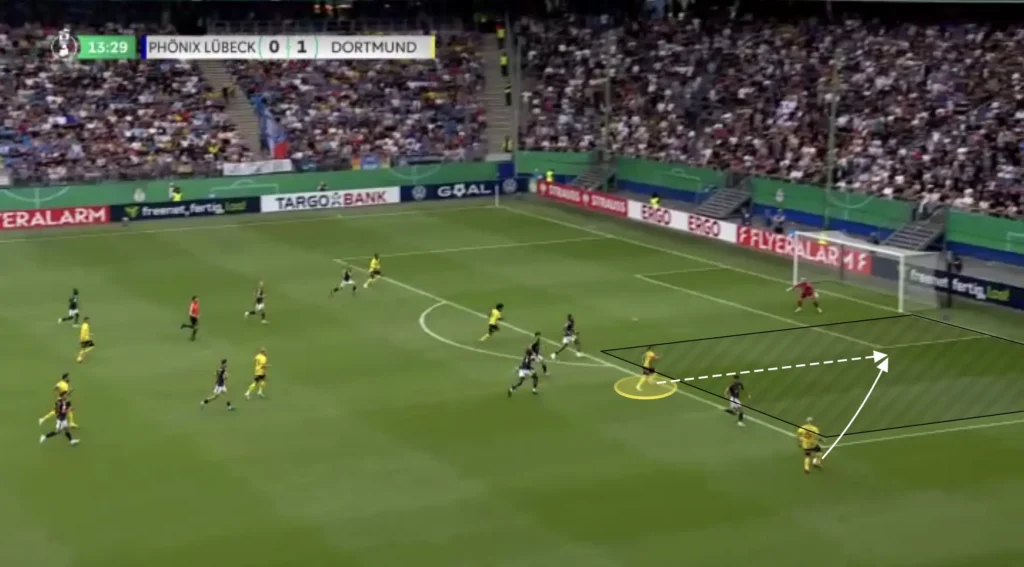
The winger does not have to play the ball to the underlapping player. The run from the attacking midfielder will often drag away an opposition defensive midfielder, which opens the space inside. The winger can take the ball inside and shoot or find a pass to a free player in front of the backline.
Defending
Low Press
Dortmund’s base formation when defending is the 1-4-4-2 formation. They look to set up in a mid-block, always trying to close the center and force the opposition out wide. Defending in the 1-4-4-2 formation is all about balance, compactness, and discipline. The team defends in two compact lines of four, with the forwards positioned ahead of the midfield. The two forwards play a crucial role, not only as the first line of defense but also in initiating the team’s pressing strategy. Şahin wants his team to stay compact without dropping too low, preferably closing the space between the midfield and backline.
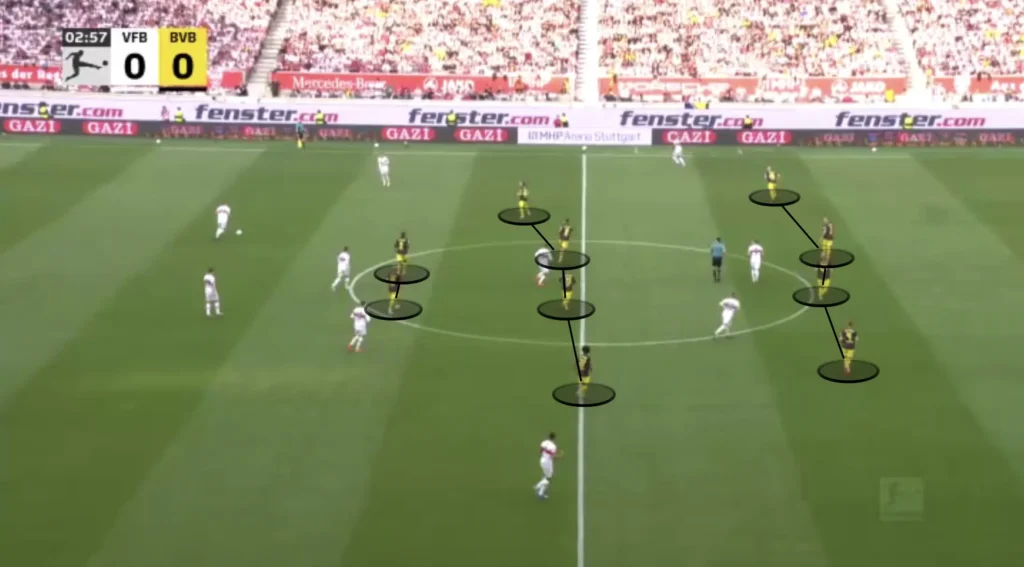
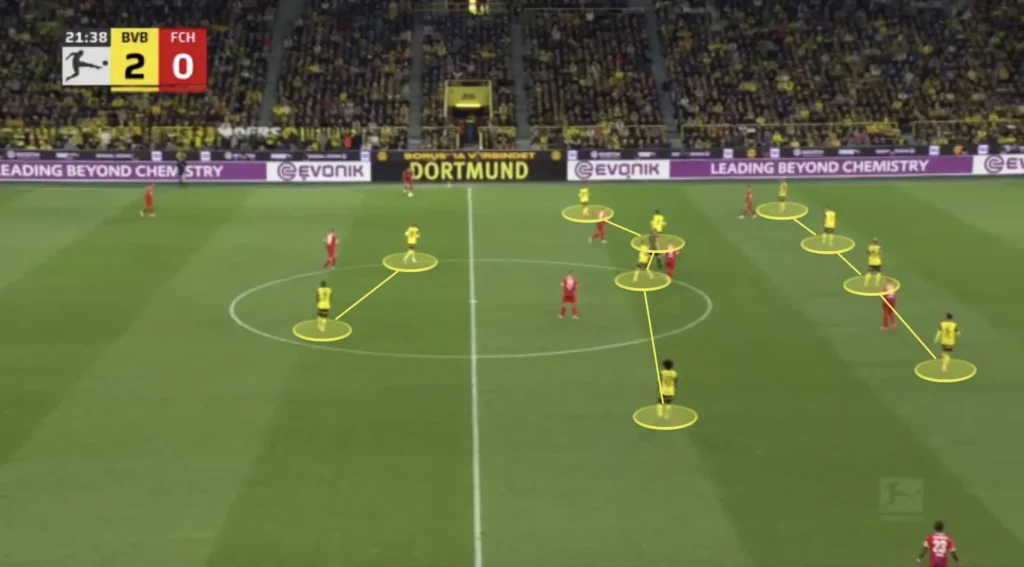
Higher up the pitch, Dortmund sometimes go into a 1-4-2-4 formation, with the wingers pushing up next to the strikers.
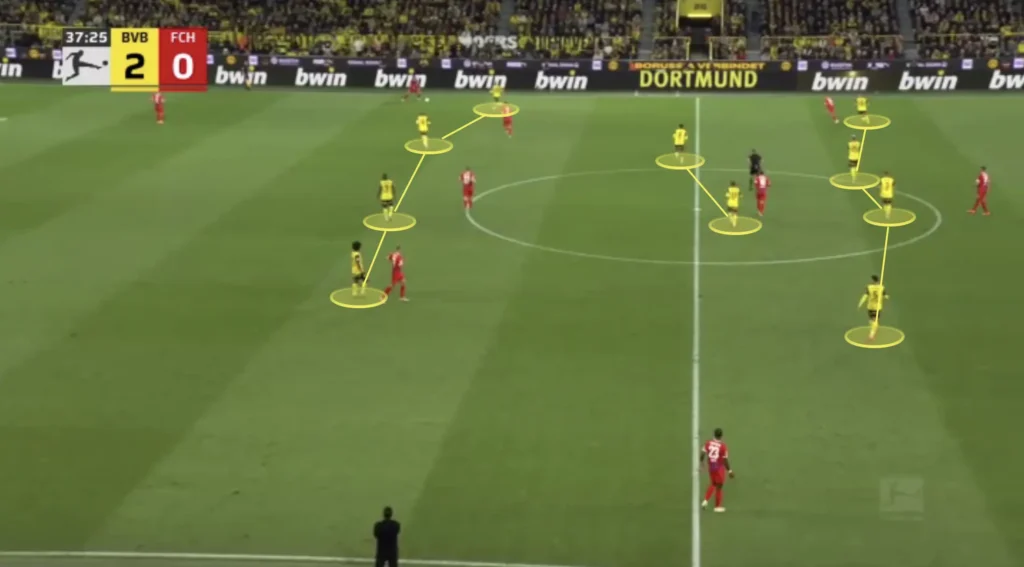
In the 1-4-2-4 formation, the wingers can press the opposition center-backs while the two strikers cover the opposition’s holding midfielders. When the wingers press the center-backs, they close the passing lanes to the opposition fullbacks/wingbacks. This forces the opposition center-backs into the middle, where Şahin wants to win the ball with the strikers, who block off all passes to the opposition midfielders.
High Backline (Def)
One tool that helps to be compact is to play with a high backline, making the space to the midfield line as small as possible. Şahin’s players do this and usually try to keep the highest line they can without leaving the space behind them too open. Defending with a high backline involves positioning the defensive line closer to the midfield, rather than near the goalkeeper. This tactic compresses the space available for the opposing team to operate, disrupting their build-up play and increasing the chances of winning the ball back quickly.
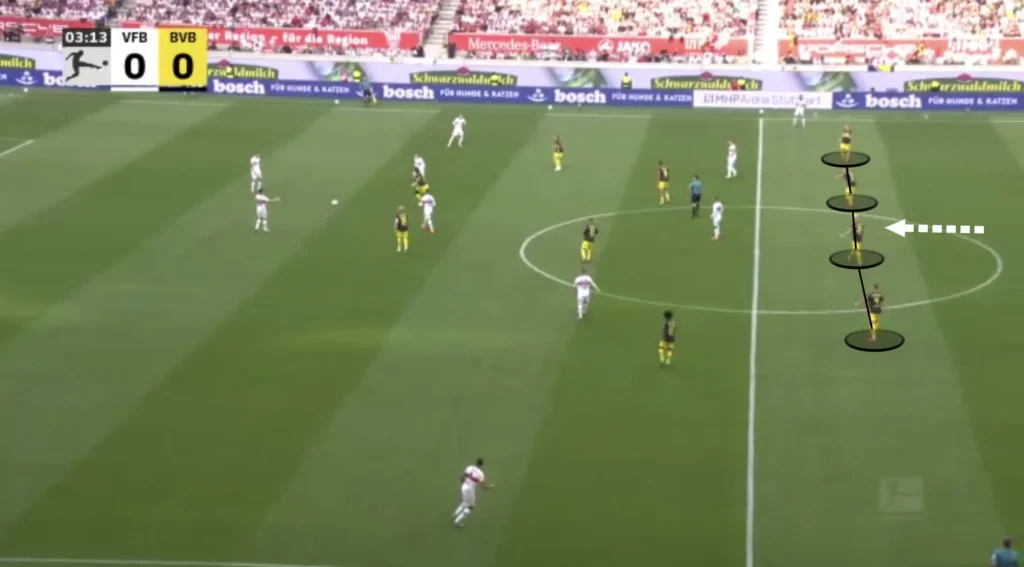
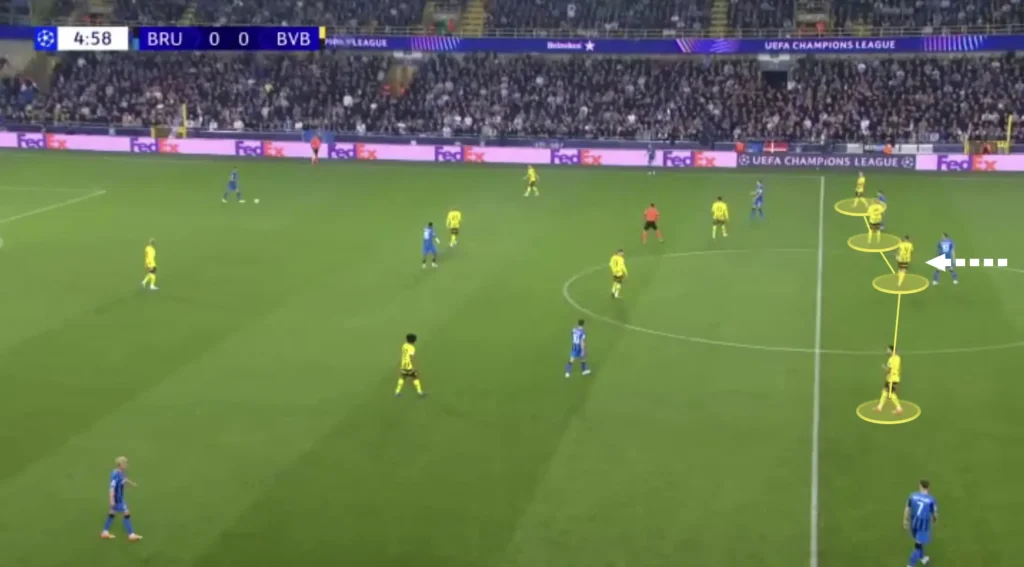
A high backline also allows defenders to support the midfield more effectively, creating numerical superiority in central areas and facilitating quicker transitions from defense to attack. However, it requires defenders with good pace and positional awareness to deal with long balls and prevent opposing attackers from exploiting the space behind. This approach demands constant communication and coordination among the backline to maintain a cohesive and effective defensive structure.
Everyone must be in the same line when defending with a high backline to maintain an effective offside trap, ensure cohesive coverage, and reduce gaps that attackers can exploit. A well-aligned defensive line makes it easier to catch opposing forwards offside, preventing them from receiving the ball in dangerous positions. Additionally, this alignment helps defenders support each other, allowing for quick transitions and coordinated movements to tackle, intercept, and clear the ball.
Squeezing the Pitch
Additionally, Nuri Şahin always wants his team to squeeze the pitch when defending. This means constantly pushing the team up as much as possible. Every time the opponent plays a slow, sideways pass or a back pass, Dortmund’s first line of pressure pushes up, with the rest of the team following to stay compact. When the next pass comes, they push up even more, forcing the opponent back even more. They do this because it pushes the opponent further away from Dortmund’s goal, making it harder to create chances.
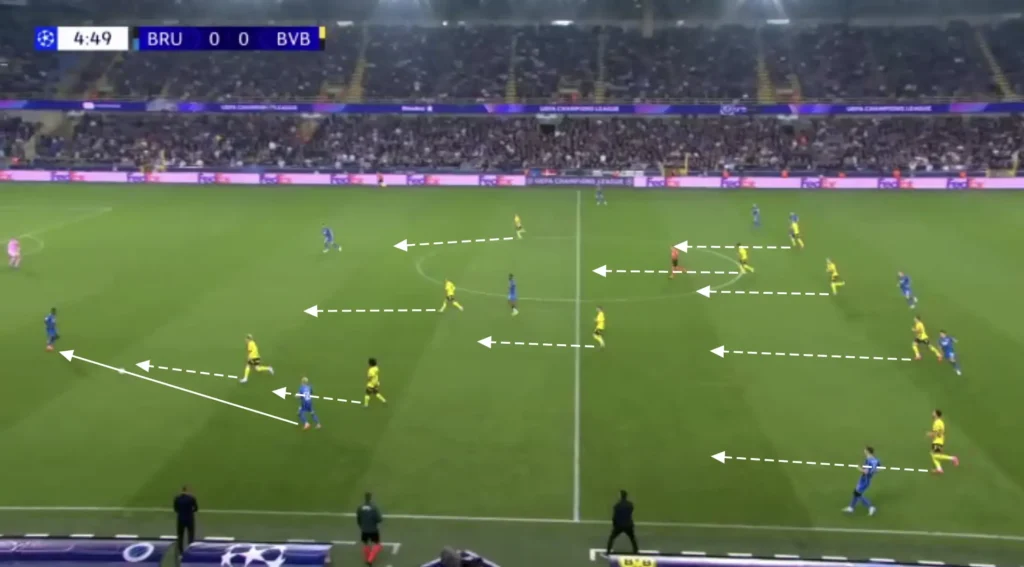
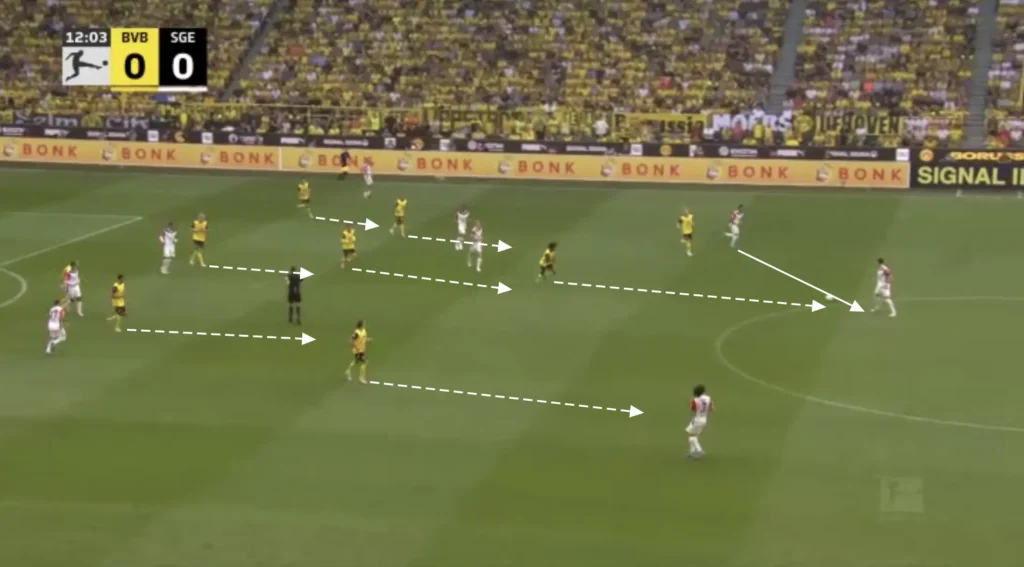
High Press
Şahin usually wants to press the opposition high up the pitch. Their pressing structure will depend on the opposition, but they primarily press in a 1-4-1-3-2 formation.
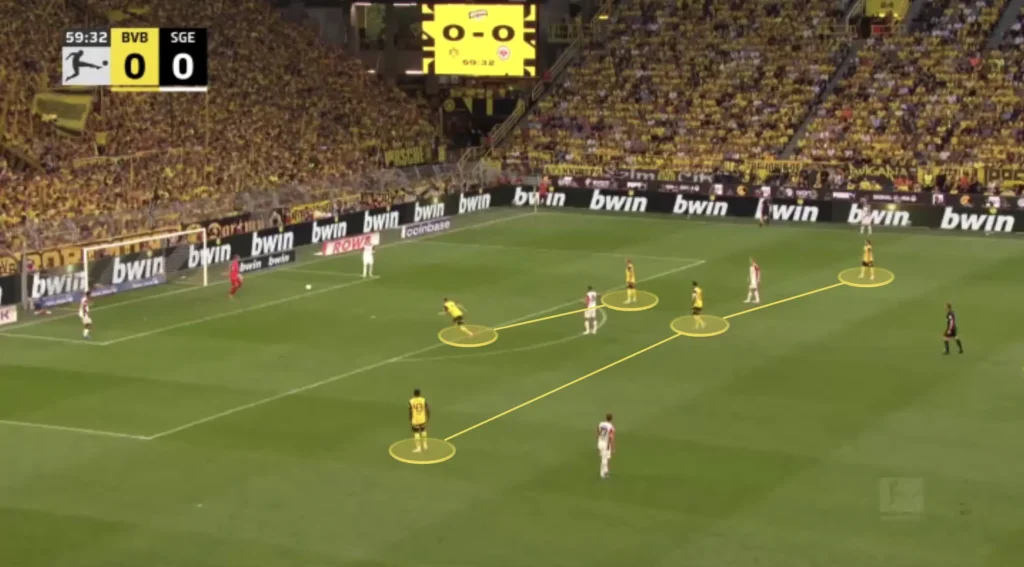
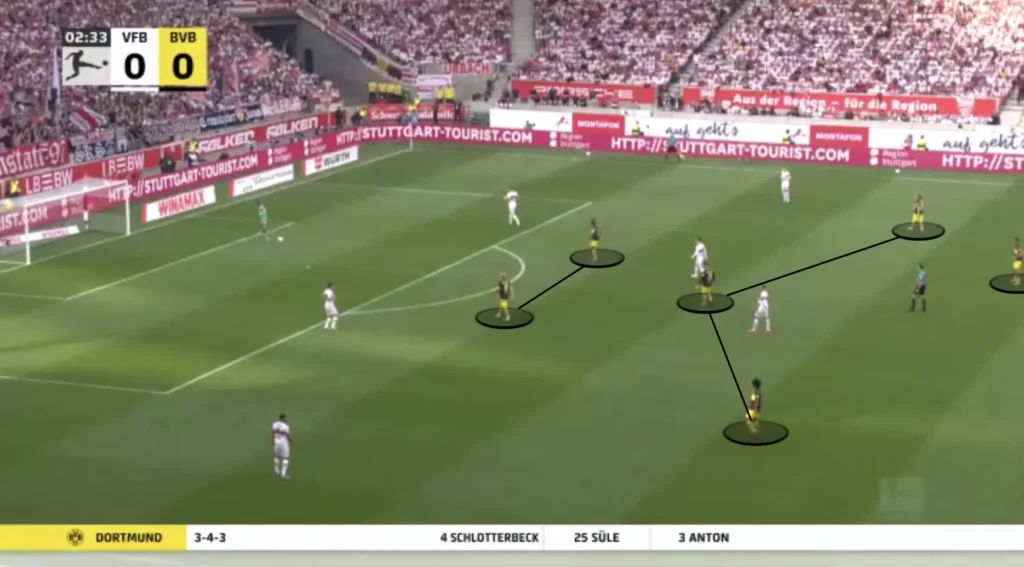
The pressing striker will try to close off one opposition center-back by making angled pressing runs, forcing the opposition to one side. The rest of the players will shift across and try to win the ball by using the touchline as an extra defender.
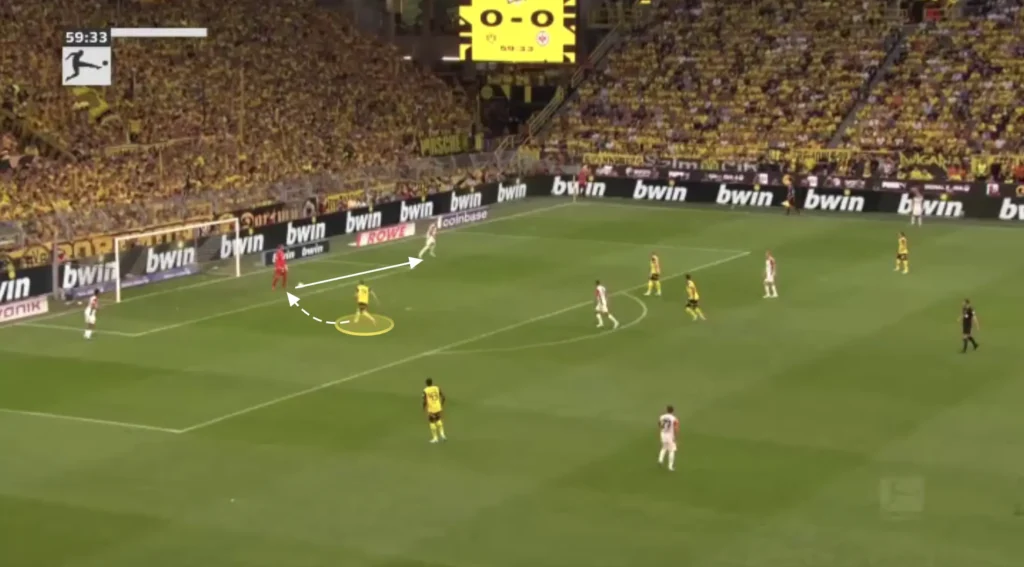
When the opposition gets pushed out to one side, Dortmund will be extremely aggressive and intensely press to win the ball. They will come across with many players, creating numerical superiorities around the ball, limiting the options for the ball-carrier, often resulting in a long ball and loss of possession.
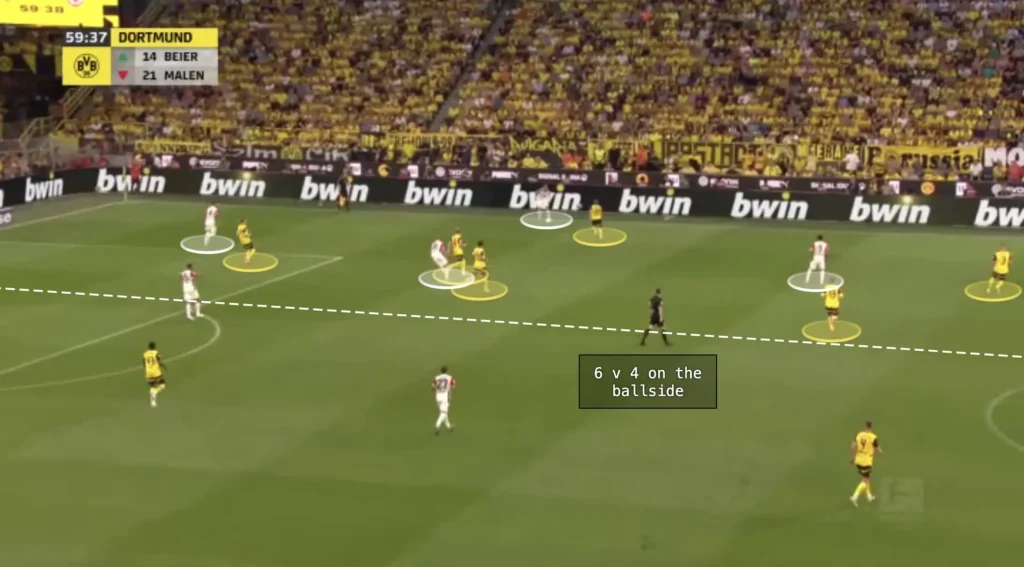
The benefit of Dortmund’s pressing system is that it gives them a numerical advantage against the opposition attackers, which gives them more control when defending long balls.
Transitions
Defensive Transitions
Dortmund are great in defensive transitions. They have many players in the middle, which creates good conditions for counterpressing. Many players close to the ball after losing possession means that many players can work towards regaining possession. Şahin’s players are also very aggressive in the first seconds after losing the ball. The four or five players closest will immediately jump on the opposition player with the ball and close the distance to cut off any passing lanes. This approach disrupts the opponent’s transition from defense to attack, forcing errors and creating opportunities to regain control in dangerous areas.
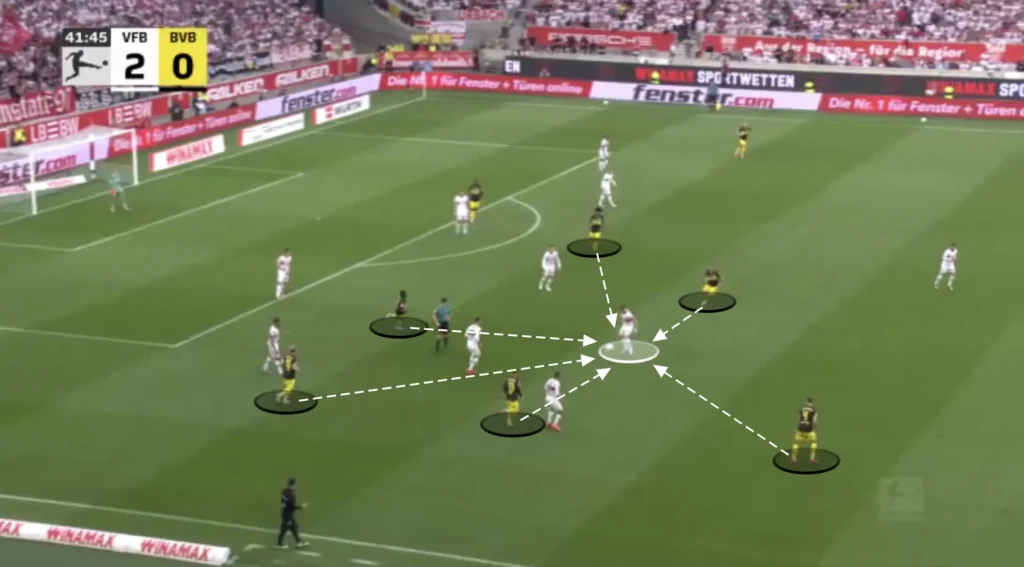
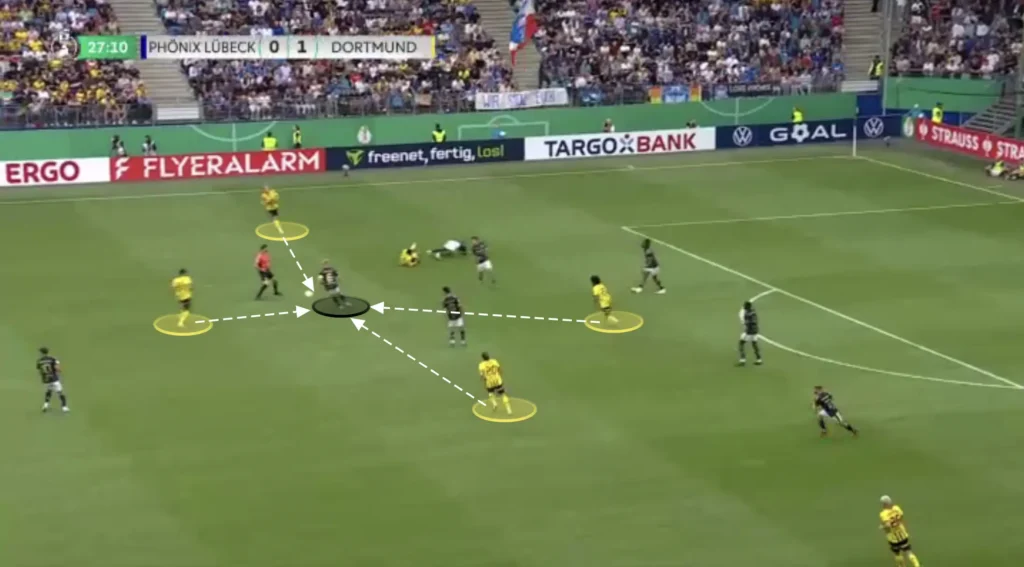
Counterpressing like this keeps Dortmund on the front foot, allowing them to dominate possession and create more scoring opportunities. However, it requires exceptional fitness, tactical discipline, and teamwork.
Offensive Transitions
Nuri Şahin also wants his team to counterattack in their offensive transitions. When winning the ball back, the team transitions quickly from defense to attack, utilizing the speed and movement of their forward players. Şahin emphasizes vertical passes to exploit spaces left by the opposition, often targeting wide areas or gaps between defenders. Dortmund’s counterattacks are well-organized, with players making intelligent off-the-ball runs to create overloads and support the ball carrier. This quick, direct style catches opponents off guard, making Dortmund a dangerous team on the break. Additionally, Dortmund’s aggressiveness means they have many players high up when defending, which enables them to incorporate more players into the counterattacks.
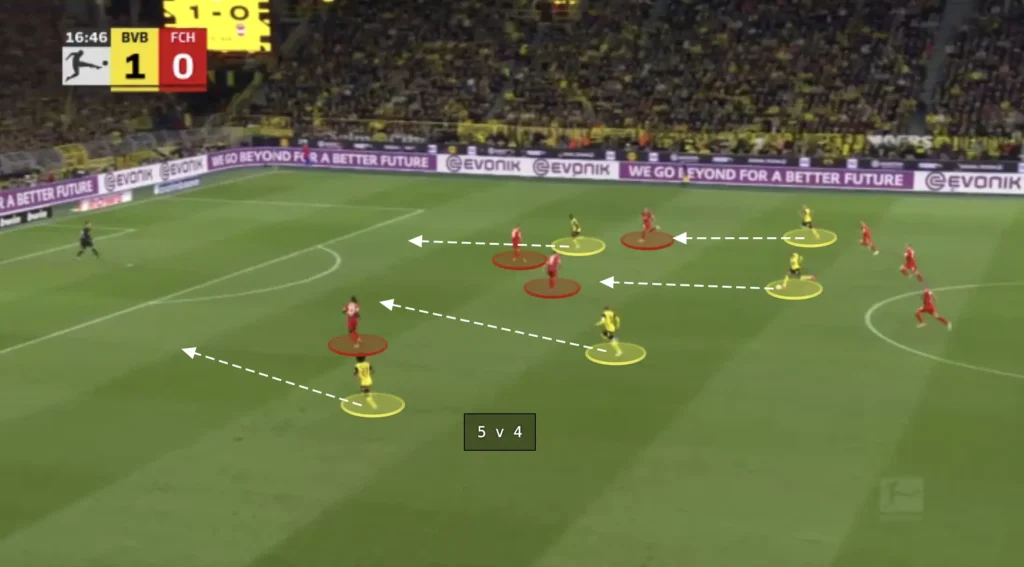
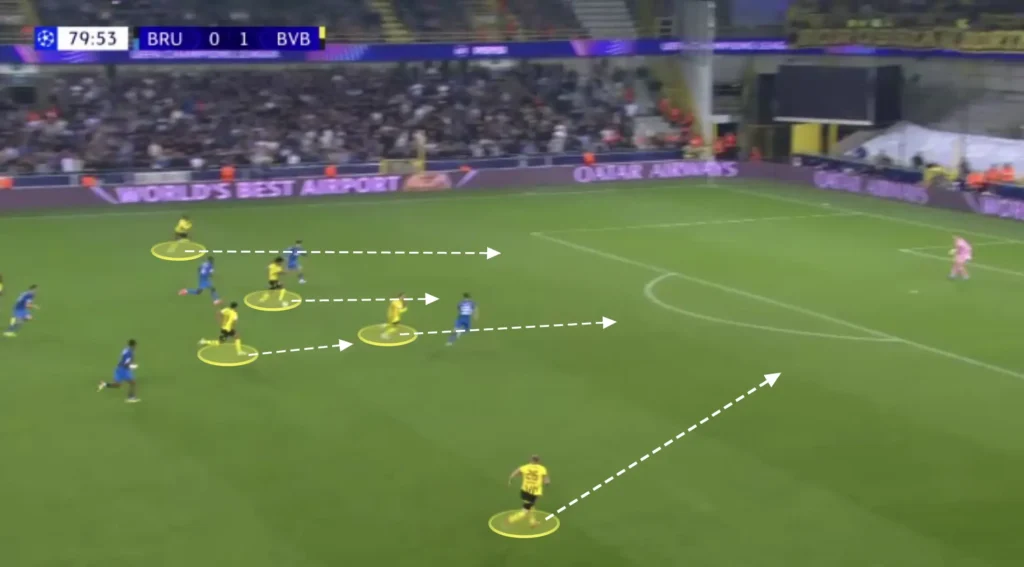
Final Thoughts
In conclusion, Nuri Şahin’s tactical approach at Borussia Dortmund reflects his deep understanding of the game, shaped by years of experience both as a player and now as a coach. His emphasis on fluid ball movement, pressing intensity, and a balance between defensive structure and attacking creativity shows a clear evolution in his philosophy. Şahin’s tactical acumen has helped Dortmund maintain their high standards of play, blending youth development with a clear, dynamic style of football.
As Şahin continues to shape Dortmund’s tactical identity, his understanding of the club’s ethos and vision ensures that the team remains competitive and exciting to watch. His influence on the pitch is a testament to his potential as a promising coach in the modern game.
